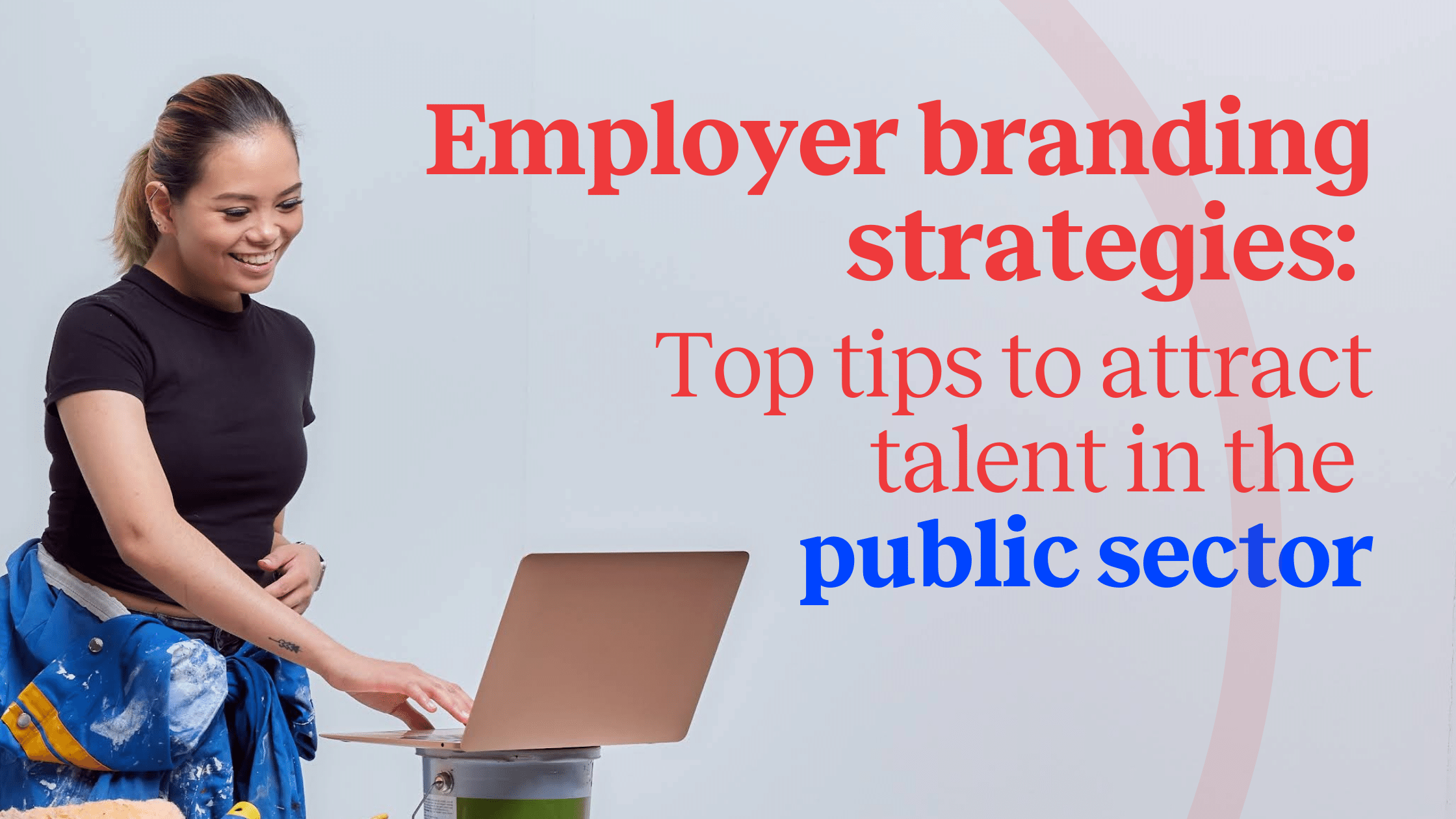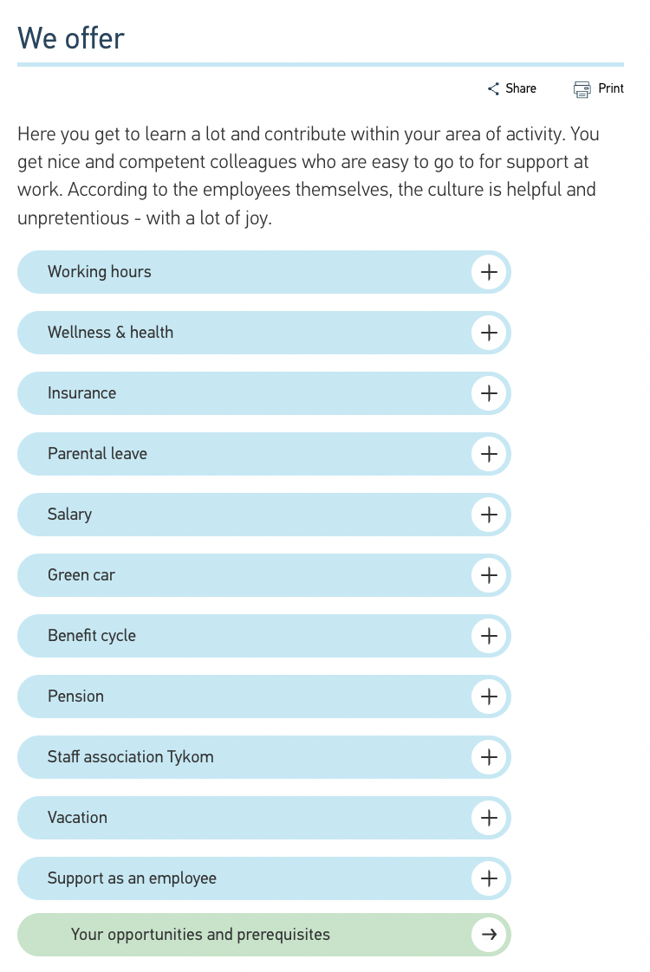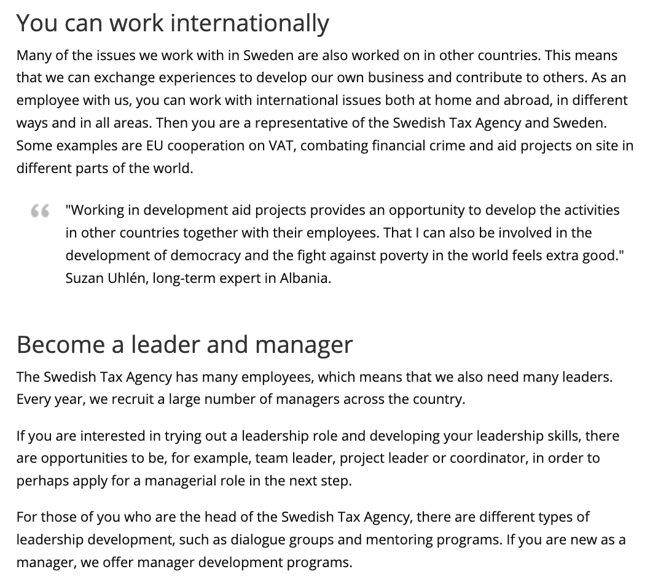
Jan Söderström

Organizations in the public sector often have an image problem. You might be seen as more traditional, formal, and bureaucratic—and less exciting and efficient—compared to your counterparts in the private sector. Plus, public sector roles tend to be associated with lower wages.
This makes it harder for you to fill vacancies, as you have to compete with big, shiny companies in the private sector (as well as other public sector organizations) for great people. You might receive plenty of applications, but not from your ideal candidates.
How could you break free of the negative stereotypes and help candidates see your organization as a great place to work?
Building and promoting a strong employer brand is key. While this isn’t an easy task, your efforts will pay off in the long-run: You’ll be better equipped to stand out from the competition, hire and retain top talent, and reduce your cost per hire.
In this post, we share tips and ideas for how to build a strong employer brand and attract candidates to your public sector organization.
Before we get into how to improve your employer brand, let’s consider some of the top advantages public sector organizations can offer employees. These are the benefits you’ll want to highlight in your employer branding activities (but more on that later).
Jobs in the public sector can give people a sense of purpose and an important role in creating impact. This is especially important for Gen Z, which will soon become the most populous generation in the world. To attract Gen Z candidates, organizations need to demonstrate their commitment to social impact and show that they take action on their ethics and values.
Public sector roles fit this description, as the work involves meeting citizens’ needs and putting public interests first. When talented employees work in the public sector, all citizens benefit.
In your recruitment marketing activities, you’ll want to highlight that a career in the public sector is for people who want to make a difference and give back to the community. Employees will find satisfaction in working for a noble cause, navigating complex challenges, and serving others.
Here's how the City of Helsinki highlights the main reason for people to work for them on their careers page:
Employees today expect flexibility to have more control over their work and personal time. Especially since the pandemic, flexibility around hours and location has been key to attract candidates. Some organizations have gone remote as a default, and many have embraced hybrid work models.
Fortunately, the public sector is well known for embracing flexible working policies. Especially for government work, flexible hours (based around a core time of hours) and part-time jobs are common. Public sector employees also typically work fewer hours than those in the private sector.
Here's an example how our customer the City of Espoo is highlighting flexibility as one of the benefits of working as a school nurse:
Due to the economic uncertainty brought about by COVID-19, start-ups have lost some of their appeal as young professionals are seeking greater job security, according to a 2021 Universum report.
Public sector jobs have the stability of government backing, which can be a major perk for high-quality candidates today.
Public sector employees tend to have comprehensive benefits packages including health insurance plans, retirement benefits, extensive paid time off, and sick days.
While there’s the assumption that public sector jobs often pay less, one study by IZA World of Labor shows that public-sector employees earn, on average, around 15% more than private-sector employees. However, private sector employees tend to have more opportunities for pay raises, since unlike some public sector jobs, private sector jobs don’t have income caps.
When communicating job benefits to candidates, be sure to talk about the overall benefits package (including flexible hours, perks, and benefits) rather than just salary, as job seekers see these as important factors.
As a public sector organization, your total benefits package might outweigh the more competitive base salary that private sector companies offer.
Here's how our customer Tyresö Municipality lists their employee perks and benefits on the website:
(Please note the original text is in Swedish and was machine-translated into English)
Public sector organizations often encourage (or require) employees to participate in training and development programs or get external qualifications to improve their skill set.
There are also plenty of opportunities for career progression, as employees can transition to different roles or departments. Public sector employees will work on projects across different sectors, and the skills they develop are often widely applicable in a range of other industries.
Here's how the Swedish Tax Agency (Skatteverket) emphasizes the many opportunities for growth within their organization:
(Please note the original text is in Swedish and was machine-translated into English)

Employees today expect the organizations they work for to reflect their values, and diversity and inclusion is continuing to grow in importance—especially for Gen Z.
Diversity across race, gender, identity, and orientation matters to Gen Z more than any generation. So organizations that pay attention to DEI and have DEI strategies in place have a big advantage over the competition.
The public sector has higher levels of diversity in senior roles compared to the private sector. In your recruitment marketing, be sure to talk about what you’re doing to promote diversity and represent a wide spectrum of people.
Strengthening your employer brand will help you communicate the main benefits you offer employees to ensure your organization is seen as a great place to work.
Alma McCarthy, professor of public sector management at the J.E. Cairnes School of Business and Economics at NUI Galway, explains the importance of employer branding work:
Our policymakers must work to future-proof the attractiveness of public sector and civil service careers and work on the employer brand to attract and retain the best talent. To do this, they need to develop strategies that appeal to the changing needs and expectations of younger generation employees.
Next, we’ll dive into practical tips to help you build and promote your employer brand.
A foundational part of employer branding is the employee value proposition (EVP), which represents the unique employment benefits you offer employees in exchange for their experience, knowledge, and skills.
Look back at the benefits listed above: Do they ring true for your public sector organization? What other key benefits do you offer employees?
While your EVP is generally built to last for several years, it’s a good idea to regularly re-evaluate it to ensure it’s aligned with the latest shift in working practices and talent needs. You want your ideal candidates to see that their personal values align with your organization.
For example, creating social impact and doing meaningful work might be a big part of your EVP as a public sector organization.
86% percent of job seekers use social media in their job search, according to CareerArc. Being active on social media will help you reach a wider audience, especially Millenials and Gen Z. When you have an engaged following on social media, you’ll likely receive applications from them after posting a job ad on your social media pages.
Communicate your values, vision, and organizational culture through photos and videos, and encourage employees to share positive stories from work as well. Job seekers are interested in the experiences of your current and past employees, so these first-hand stories will have a larger impact on them.
You can also communicate directly with citizens and potential candidates by asking questions and running polls to engage people, and answering their questions in comments and videos.
Being open on social media and showing the faces of your employees helps to humanize your organization and build trust.
Many public sector organizations have a hard time keeping up with the latest recruitment technology. By using modern tools like video recruitment software, you’ll be seen as a modern employer and you’ll be able to screen candidates faster and make better hiring decisions.
For example, when the Social Insurance Institution in Finland conducted pre-recorded video interviews, they received praise from younger candidates that their image was unprejudiced and youthful, thanks to using modern interviewing methods.
As part of the video interview process, you can share introductory and employer branding videos, which give you the opportunity to set the tone for the interview process and promote your organizational culture.
 “I think video interviews are a great tool for employer branding. You can ask questions in different environments so that candidates can see what it’s like and meet different people. In a normal interview, you usually meet one recruiter and one manager. But with video interviews, you can meet five to six different people.”
“I think video interviews are a great tool for employer branding. You can ask questions in different environments so that candidates can see what it’s like and meet different people. In a normal interview, you usually meet one recruiter and one manager. But with video interviews, you can meet five to six different people.”
— Patrik Reman, Unit Manager of Competence Supply Unit & HR Business Management at Gävle kommun
Pre-recorded video interviews ensure a fair hiring process, as you ask all candidates exactly the same standardized questions. One in four very large employers reported that virtual recruiting has helped them take a more diverse/inclusive approach, according to a 2021 Universum report.
Video interviews can also help you find unicorn candidates that you might not consider based on their CVs.
For example, let’s say you’re recruiting for healthcare roles where strong language skills are important. If you were only CV screening, you might disregard some applicants with foreign names and cover letters with typos. But when you see the same candidates on video, you might see that the way they speak and present themselves is exactly how you want healthcare workers to speak with patients.
|
Pro tip: Record the video questions on your phone from where the work will take place, and have your colleagues ask some questions. That way, you can show candidates the work environment and they can meet the team early in the process, which makes for brilliant employer branding. |
Your employer brand is the perception your current and potential customers have of your company. So providing an excellent candidate experience through the entire hiring process is crucial to improve your employer brand.
“As many industries in Finland are facing a talent shortage, the first contact comes more and more often from the recruiter, not from the candidate. This means that the recruitment process needs to be fast, efficient, and candidate friendly. You can’t put the candidate through a complex process—you’d just lose them during that.”
— Juho Toivola, Organizational Psychologist and Recruitment Trainer
Keep in mind that the candidate experience starts even before they apply—make sure your career page draws people in and tells about your organizational culture. Openly communicate with candidates about how the hiring process will go, keep them up to date along the way, and provide useful feedback with them after the interview process.
Video interviews, as mentioned above, also help to improve the candidate experience by giving people a clearer view of your organization, and allowing them to record their video answers whenever they have the time.
Your entire recruitment process should also be digitized and mobile optimized to make it as smooth as possible for recruiters and candidates. You should be able to manage the entire hiring process from your recruitment platform—you don’t want any random Excel sheets or Word docs. This is especially important with the rise of remote and hybrid work. When colleagues in your department work from home, they shouldn’t be missing any papers from the office.
“I think the best thing to do is talk to others who are working on developing their employer brand,” says Patrik Reman.
“Ask a lot of questions and join different networks to get input on how to develop your employer brand and what to do first. That way, you don’t have to make the same mistakes that others have made. Some organizations are good at social media, and others aren’t. Some are good at the candidate experience at the beginning, but maybe lose candidates down the line. We have a lot to learn from each other,” Patrik continues.
You don’t always have to look outside your organization for advice, especially in larger public organizations with thousands of employees. Talk to people from different functions who have a relevant background and skill set to get new ideas for employer branding.
What’s the biggest mistake when it comes to employer branding? Doing nothing.
Many organizations simply wait around for their applicant tracking system to improve or to have new features. Instead, take the initiative to try new things.
“A lot of people are afraid to try new things because they’re worried about doing it wrong or wondering “Am I allowed to do this?” You can always try something for six months to a year and then evaluate how it went. Did you get more applicants? Are candidates happier? Just try new things,” explains Patrik.
Want more tips for building your employer brand? Download our free hands-on employer branding guide here.
Get recruitment insights, tips, and best practices delivered to your inbox monthly!